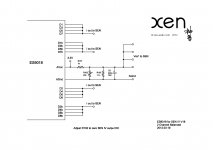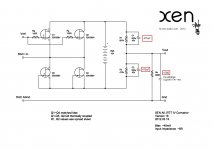What is the right schematic in this thread for balanced operation from a Buffalo III? Currently I have one module in SE and will upgrade to two for dual mono. I don't see any boards currently being offered am I right?
If you are actually doing dual mono (one Buf III per channel) then you will probably need to do point-to-point as there isn't (or never was) a board for that.
Attachments
For the first time in years I have had some time for diy projects again. My SEN V18 has been running fine for almost five years now despite some hum which I was able to solve recently. I have soldered Riv and Civ to a small perf board close to the output connector. The quality of that perf board is not very good and last week I lost one phase of the right channel due to that. I thought I should redo that solution and started to think about values of Civ and Riv. I realized I did not adjust Civ for the lower Riv used with the BIII. I am using 200pF and 330 ohm. When looking at the schematic just posted I noticed that the value for C1 and C2 is changed to 470uF while I am using the standard 220 uF. Should I change that?
The es9018 in stereo mode have 16mA pk to pk. With 150ohm Riv that will give 2.4V pk to pk. Which gives an amplitude of 1.2V and 0.85Vrms (SE) if I am not mistaken. Isn't that a little low?
The es9018 in stereo mode have 16mA pk to pk. With 150ohm Riv that will give 2.4V pk to pk. Which gives an amplitude of 1.2V and 0.85Vrms (SE) if I am not mistaken. Isn't that a little low?
The value of C1, C2 is not so important.
No need to change.
Patrick
Thanks Patrick!
You need 390 ohm high quality resistor for 2V rms, unbalanced for BIII. I'm using 1000uF Nichicon ES capacitors. Capacitors are larger so some of the components should be on bottom side. You can use one of the existing pad and drill another hole in copper free area then bend lead to the other pad after cap mounting.
220µF-390R is 1.85 Hz.
Low enough for me.
Patrick
 Yes, indeed.
Yes, indeed.If you are actually doing dual mono (one Buf III per channel) then you will probably need to do point-to-point as there isn't (or never was) a board for that.
I know that I have to add components to the V18 boards to get it to work with the BIII but from what I under stand when you put the BIII in dual mono mode it parallels the dacs in the chip so I shouldn't need more that two V18 eval boards correct? Or di I have to change values in the ess9018 scematic?
Hi sbelyo
If I remember correctly the maximum current output from a dual mono Buffalo is too high to maintain low distortion with the dual paralleled lsk369 fets recommended for use with a stereo Buffalo 2 or 3. You could add two more but, apart from the need for 32 matched devices the input capacitance of the stage would rise unacceptably.
To be honest I've never understood the appeal of the dual mono arrangement. All that extra circuitry for a surely inaudible increase in s/n ratio. Any sonic advantage perceived, if not just expectation bias, must come from separating left and right processing into two separate chips I suppose. And Russ at Twisted Pear has reported that the output level between ESS1018's is highly variable, negating its theoretical benefits, if I've understood correctly.
Apparently the new ESS1038, to be used in buffalo 4, has a much higher output current level, too much for Sen, or Legato or Ivy for that matter. Russ has designed a completely new I/V stage to cope.
Sorry to be negative, but hope this helps
Paul N
If I remember correctly the maximum current output from a dual mono Buffalo is too high to maintain low distortion with the dual paralleled lsk369 fets recommended for use with a stereo Buffalo 2 or 3. You could add two more but, apart from the need for 32 matched devices the input capacitance of the stage would rise unacceptably.
To be honest I've never understood the appeal of the dual mono arrangement. All that extra circuitry for a surely inaudible increase in s/n ratio. Any sonic advantage perceived, if not just expectation bias, must come from separating left and right processing into two separate chips I suppose. And Russ at Twisted Pear has reported that the output level between ESS1018's is highly variable, negating its theoretical benefits, if I've understood correctly.
Apparently the new ESS1038, to be used in buffalo 4, has a much higher output current level, too much for Sen, or Legato or Ivy for that matter. Russ has designed a completely new I/V stage to cope.
Sorry to be negative, but hope this helps
Paul N
Not true.
You can use a pair of LU1014 triode cell at 200mA (or more) to make up a SEN.
Can swing any voltage / current.
You can also use 16x BF862 cascoded by J111 in parallel.
Very low capacitances as well.
If that is not enough, you can also use the Zen V9 LU1014 triode cell.
I believe the bias is 1.3A.

Patrick
You can use a pair of LU1014 triode cell at 200mA (or more) to make up a SEN.
Can swing any voltage / current.
You can also use 16x BF862 cascoded by J111 in parallel.
Very low capacitances as well.
If that is not enough, you can also use the Zen V9 LU1014 triode cell.
I believe the bias is 1.3A.
Patrick
This variant of the SEN I-V uses the available and inexpensive SMD BF862 jfet cascoded by J111, 3 in parallel ... and since we are doing overkill, let's go all the way and mirror balanced I-V circuits.
thank you for this great Idea to use bf862
what for Is R4
why there Is no C I/V
No, because a LU1014 SEN still has floating supplies and Zout = R_iv.
That does not change.
But you can use a high value R_iv (in TO220) to output say 20V from a 9018/38.
And then you can follow it by a normal DAO to drive headphone directly.
Without an additional gain stage (HAGS).
Patrick
That does not change.
But you can use a high value R_iv (in TO220) to output say 20V from a 9018/38.
And then you can follow it by a normal DAO to drive headphone directly.
Without an additional gain stage (HAGS).
Patrick
> But you can use a high value R_iv (in TO220) to output say 20V from a 9018/38. And then you can follow it by a normal DAO to drive headphone directly.
Without an additional gain stage (HAGS).
I might try this with an ES9018 as I anyway have a balanced DAO on my plate and Buffalo's in the drawer
Without an additional gain stage (HAGS).
I might try this with an ES9018 as I anyway have a balanced DAO on my plate and Buffalo's in the drawer
No point, unless you have a lot of output current.
The LU1014 has high capacitances, and the penalty is gate current induced distortion.
If you want a high output voltage from ES9018, just cascode the 2SK369s with say a 2SK2013 at Vgs 9V.
You will of course increase your supply voltage to cover 2x cascode plus the high voltage output swing.
Probably something like 60V.
Patrick
The LU1014 has high capacitances, and the penalty is gate current induced distortion.
If you want a high output voltage from ES9018, just cascode the 2SK369s with say a 2SK2013 at Vgs 9V.
You will of course increase your supply voltage to cover 2x cascode plus the high voltage output swing.
Probably something like 60V.
Patrick
thank you for this great Idea to use bf862
what for Is R4
why there Is no C I/V
You are welcome but the idea is from Patrick.
R4 is optional.
C I/V is also optional -- particularly if the input to the next stage contains a similar C
- Home
- Source & Line
- Digital Line Level
- Zen -> Cen -> Sen, evolution of a minimalistic IV Converter

